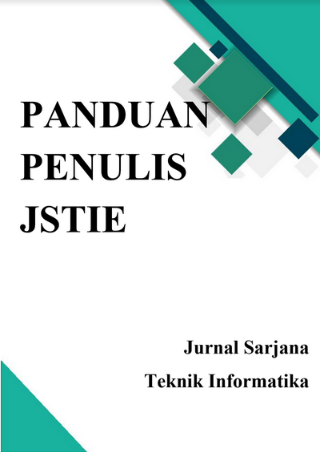MEDIA PEMBELAJARAN TEORI BAHASA AUTOMATA PADA MATERI PUSH DOWN AUTOMATA BERBASIS MULTIMEDIA
DOI:
https://doi.org/10.12928/jstie.v2i2.2848Abstract
Pembelajaran Teori Bahasa Automata pada materi Push Down Automata bagi sebagian mahasiswa sangatlah susah dipahami. Berdasarkan data yang diperoleh dari 30 mahasiswa bahwa jumlah mahasiswa yang tidak memahami materi Push Down lebih banyak dari pada mahasiswa yang paham akan materi, untuk itu perlunya dibangun aplikasi pembelajaran TBO khususnya pada materi Push Down Automata agar dapat digunakan mahasiswa sebagai sarana belajar dan mempermudah dosen menyampaikan materi.
Subjek dalam penelitian ini adalah aplikasi multimedia sebagai media pembelajaran Teori Bahasa Automata pada materi Push Down Automata. Pengumpulan data dalam penelitian ini menggunakan metode studi pustaka, metode observasi, dan metode wawancara. Aplikasi disusun dengan prosedur yang mencakup indentifikasi masalah yang diperoleh, analisis kebutuhan, merancang konsep, merancang isi, design document, dan diagram navigasi, merancang naskah, merancang grafik, memproduksi sistem, pengetesan sistem dengan black box dan alpha test.
Hasil penelitian ini adalah aplikasi multimedia sebagai media pembelajaran Teori Bahasa Automata pada materi Push Down Automata bagi mahasiswa Program Studi Teknik Informatika di Universitas Ahmad Dahlan yang berdasarkan hasil uji coba tersebut dapat disimpulkan bahwa aplikasi pembelajaran ini dapat membantu proses pembelajaran pada mahasiswa untuk memahami materi dan dapat digunakan sebagai alat bantu dosen untuk menunjang pembelajaran Teori Bahasa Automata.
Â
Kata Kunci : Teori Bahasa Automata, Push Down Automata, Multimedia.References
Nasution, S, Prof. Dr. M. A., 2006, Berbagai Pendekatan Dalam Proses Belajar Dan Mengajar, Bumi Aksara, Jakarta
http://ginigitu.wordpress.com/2009/04/21/multimedia-sebagai-media-pembelajaran-interaktif/#comments, diunduh 27 maret 2011
Harianto, Bambang, Ir.,M.T,2004, Teori Bahasa Otomata dan Komputasi Serta Terapanya, Informatika, Bandung.
Febriyana tentang “Pengembangan Aplikasi Ejaan Bahasa Indonesia Dengan Konsep FSA (Finit State Automata)
http://usmanrizal.blogspot.com/2008/10/quantum-learning.html, Dr. Vernon A. Magnesen, 1983, tentang teknik belajar. Diunduh 27 maret 2011
Utdirartatmo, Firrar, 2001, Teori Bahasa dan Otomata, J&J Learning, Yogyakarta.
Downloads
Published
Issue
Section
License
License and Copyright Agreement
In submitting the manuscript to the journal, the authors certify that:
- They are authorized by their co-authors to enter into these arrangements.
- The work described has not been formally published before, except in the form of an abstract or as part of a published lecture, review, thesis, or overlay journal. Please also carefully read Journal Posting Your Article Policy.
- The work is not under consideration for publication elsewhere.
- The work has been approved by all the author(s) and by the responsible authorities – tacitly or explicitly – of the institutes where the work has been carried out.
- They secure the right to reproduce any material that has already been published or copyrighted elsewhere.
- They agree to the following license and copyright agreement.
Copyright
Authors who publish with Jurnal Sarjana Teknik Informatika agree to the following terms:
- Authors retain copyright and grant the journal right of first publication with the work simultaneously licensed under a Creative Commons Attribution License (CC BY-SA 4.0) that allows others to share the work with an acknowledgement of the work's authorship and initial publication in this journal.
- Authors are able to enter into separate, additional contractual arrangements for the non-exclusive distribution of the journal's published version of the work (e.g., post it to an institutional repository or publish it in a book), with an acknowledgement of its initial publication in this journal.
- Authors are permitted and encouraged to post their work online (e.g., in institutional repositories or on their website) prior to and during the submission process, as it can lead to productive exchanges, as well as earlier and greater citation of published work.







